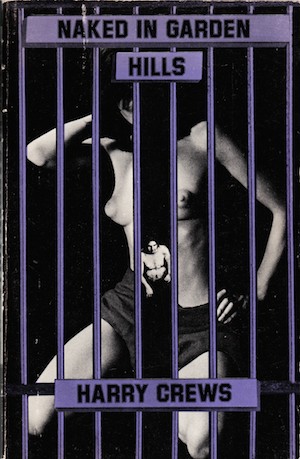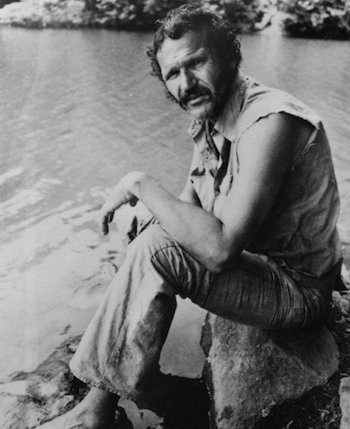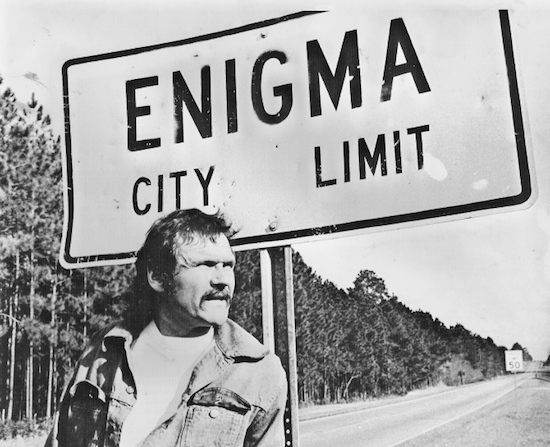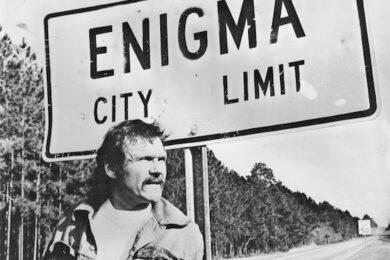Writers who iconic, cult-status musicians express a direct affinity for often have an edgy, outsider-like quality which resonates with their own sense of artistic identity. ‘Literary outlaw’ William Burroughs (whose writings gave names to the Soft Machine and Steely Dan), Charles Bukowski (a clear influence on Tom Waits and innumerable lesser artists), and then there’s Harry Crews. I first became aware of his name in 1989, after Lydia Lunch, Kim Gordon and drummer Sadie Mae formed the No Wave/hardcore punk influenced band Harry Crews named in honour of the author and released an album named after one of his novels, Naked In Garden Hills. Thurston Moore, too, was a fan, writing on the front cover blurb for his last novel An American Family: “God bless Harry Crews, America’s best writer. He’ll break your heart but he’ll always bring you love.” When I asked Moore about Crews just before one of his recent shows at Cafe Oto, he said: “He was the real deal that guy. He had his hat pulled down real low, cowboy boots on and on his arm that tattoo that read: How do you like your blue eyed boy Mr Death?”
The quote, from the poem ‘Buffalo Bill’s’ by E.E Cummings, was neither simply male bravado nor some casual affectation. Coming from an extremely poor tenant farming background in Bacon County, Georgia, Crews was afflicted by a childhood illness (most likely polio) which temporarily deprived him of the ability to walk, then was bedridden a second time after falling into a cauldron of boiling water used to remove the hair from slaughtered hogs. This kind of misadventure was clearly par for the course in the community in which Crews grew up, as he wrote in A Childhood: The Biography of a Place: “Nearly everybody I knew had something missing, a finger cut off, a toe split, an ear half-chewed away, an eye clouded with blindness from a glancing fence staple. And if they didn’t have something missing, they were carrying scars from barbed wire, or knives, or fishhooks.” Add to that the death of his father when he was only two, the violent alcoholic stepfather who raised him (who was also his father’s brother) and the startling image of the young Crews after his family had moved to Jacksonville in awe at the sight of the first indoor faucet he had ever seen, and it begins to become apparent that the tattoo’s sentiment was well earned even before he had begun to approach adulthood.
Although no writer can honestly be said to live up to such a well-intentioned hyperbolic epithet as “America’s Best Writer” (there are so many different kinds of writing to start with), he is undoubtedly one of the American South’s most unique and visceral voices. Certainly, his books are the only ones I have read where the physical sense of excitement and tension is such that I have to put the book down and stop to pause while I catch my breath. Despite the often extremely violent events depicted in his work, Crews’ keen sense of empathy with his characters is what renders his fiction so compelling. Although some have suggested that his larger-than-life persona at times threatened to overshadow his writing, he was also a hugely popular teacher of creative writing at the University of Florida (for 30 years, until his retirement in 1997), where he attempted to impart his core belief that: "A writer’s job is to get naked, to hide nothing, to look away from nothing, to look at it. To not blink, to not be embarrassed by it or ashamed of it. Strip it down and let’s get to where the blood is, where the bone is."
Despite his cult status, many of his novels are currently out of print and none are available in digital form. Whilst I’ve never been particularly interested in collecting rare books, my Harry Crews obsession increased in intensity after hearing of his death two years ago on March 28 2012, prompting me to seek out the few rarer volumes I hadn’t yet read. The £75 I paid for a tattered paperback copy of Naked in Garden Hills was worth every penny and further convinced me that Crews was a writer deserving of being brought to a wider audience. Perhaps partially because of his not undeserved image as hellraiser and general badass, there is also little in the way of serious critical studies concerned with his writing. The one volume that does exist, edited by Erik Bledsoe, contains many valuable insights, as well as a few excessively abstruse literature professor style sentence constructions that would surely have nonplussed Crews himself. Bledsoe, however, captures the essence of Crews’ appeal perfectly in his introduction, when he writes in regard to A Childhood how “the power of his language, his ability to invoke a world that is essentially alien to me and make poetry out of its roughness amazed me.” Crews himself seemed to feel that the strength and fury of his work was directly derived from his bluntness. As he said in an interview that appears in Getting Naked With Harry Crews (also edited by Bledsoe): “I do not admire well-rounded people nor their work. So far as I can see, nothing good in the world has ever been done by well-rounded people. The good work is done by people with jagged, broken edges, because those edges cut things and leave an imprint, a design.”
Crews, who would have been 79 yesterday, harboured the desire to become a writer from an early age, when he and childhood playmate Willalee Bookatee used to make up stories to accompany the images that they found in a Sears, Roebuck catalogue. After spending time serving with the US Marines during the Korean War (aged 17 when he enlisted), Crews used the GI Bill to educate himself and his own personal dissection and analysis of Graham Greene’s The End of the Affair to teach himself the craftsmanship required for becoming a novelist. At first Crews rejected his background, until an epiphany made him realise that he needed to write about the very things that defined him. He spent 18 months riding across America on a Triumph motorcycle, worked as a bartender, short order cook and a carnival barker. In the introduction to A Childhood, Crews relates the lasting impression that a glimpse from behind the scenes at the freak show had left upon him.
“I was especially fond of the Fat Lady and her friends there under the tent. I think I know why, and I know I know when, I started loving freaks. I had been able to rent a place to sleep from a freak man and his freak wife and I woke up one morning looking at both of them where they stood at the other end of their trailer in the kitchen. They stood perfectly still in the dim, yellow light, their backs to each other. I could not see their faces but I was close enough to hear them clearly when they spoke.
“What’s for supper, darling?” he said.
“Franks and beans with a nice little salad,” she said.
…I have never stopped remembering that as wonderous and special as those two people were, they were only talking about and looking forward to and needing precisely what all the rest of us talk about and look forward to and need.”
Some critics have damned him as a writer of caricatures but I believe it’s important to remember that because of his childhood illness, Crews felt himself what it was like to be considered a freak. As another Southern writer to whom he has often been compared, Flannery O’Connor, noted: “I have found that anything that comes out of the South is going to be called grotesque by the Northern reader, unless it is grotesque, in which case it is going to be called realistic.” John Williams from GQ once likened Crews work to being “like Flannery O’Connor on steroids.” Crews was clearly an ardent admirer of her work, as he was of Andrew Nelson Lytle, the Southern American novelist, dramatist and professor of literature, who was one of the first champions of O’Connor’s fiction, as well as one of Crews’ early creative writing tutors at the University of Florida. As was first related in an article in Rolling Stone, Lytle returned one of Crews’ early fictional efforts with the advice: “Burn it, son. Fire’s a great refiner.” Whilst they both shared a basic concern for the spiritual question of what a person’s place is in the world, O’Connor wrote from a position informed by her Roman Catholic faith, whereas Crews began from the nihilistic proposition ‘God is dead’ and then asked the question: what does that leave us to believe in? The sense of being out of place is therefore greatly heightened in Crews’ work as the old world confronts the shock of the new. The aptly named Herman Mack attempts to eat an entire Ford Maverick, four ounces at a time, in Car, thereby articulating Crews’ publicly confessed hatred of the ubiquitous automobile. Dorothy Turnipseed attempts to turn herself into female bodybuilding champion Shereel Dupont in Body, but she cannot escape her family, her past, or the violent retribution eventually wreaked by her psychopathic Vietnam Vet fiancee Harry ‘Nail Head’ Barnes.
Prior to the publication of The Gospel Singer in 1968, Crews had written five novels and a “roomful of short stories” and all he had to show for it was $100 from a single story bought by the Sewanee Review. When that novel was accepted for publication, Crews called up his mother Myrtice and excitedly related the news. She said cautiously: “you didn’t pass it off as the truth did you?” When he told her that they knew he had made it up, her response was priceless: “You mean they taken and given you good money for something they known to be a lie?” Enigma, Georgia is the birthplace of the never named Gospel Singer, an amoral vocalist with a heavenly voice who exploits religion to feed his ever present desire for sexual conquest. Despite the Gospel Singer’s publicly avowed intention to save the souls of those who hear his beautiful voice, in reality his actions bring about almost all of the suffering in the book. His cruel treatment of his childhood sweetheart, MaryBell Carter, is the catalytic event that turns her into a manipulative whore, which eventually leads to her murder at the hands of his childhood friend Willalee Bookatee Hull. When the Gospel Singer confesses his sins and the charlatanic nature of his supposedly miraculous healing ability at a tent revival, he incites the mob to disastrous retribution. If it sounds rather grim, then that’s because it is. It is also an extremely powerful debut novel, even if it doesn’t quite reach the reach the heights of Crews’ best work.

Crews’ second novel, Naked in Garden Hills, first published in 1969 and now long out of print, was reputedly the author’s favourite, leading him to exclaim in interviews: “Man, I sure was crazy when I wrote that.” Although it received positive reviews when it first appeared, as far as I’m aware, the only times it has appeared in print was the hardcover release in 1969, a US paperback in 1970 and a Charisma Books UK paperback in 1973. The novel is indeed a unique and crazy beast, clothing a gritty, no-nonsense depiction of character’s foibles and failings in proceedings so strange as to appear as surrealistic and grotesque as a Hieronymus Bosch painting. Garden Hills is a ruined town at the bottom of a phosphate pit in Florida owned by the morbidly obese Aaron Mayhugh Jr, known to the town’s inhabitants as Fat Man, a six-hundred pound diet-milkshake addict who drinks the stuff by the caseload. Jester, a four-foot tall ninety-pound midget, spends his days working for Fat Man and dreaming of races he never won. Dolly is the Phosphate Queen of Garden Hills, recently returned from New York City in search of the now absent entrepreneur Jack O’Boylan who set up the phosphate mine, to establish a go-go club in Garden Hills. Fat Man’s incessant dreams of food eventually lead him to an utterly bizarre conclusion where he is forced to exhibit himself suspended from the ceiling in a golden cage where he must maintain his position as the number one attraction in Dolly’s sideshow of freaks, whilst Jester, adorned in jockey silks, rides his adoring ex-whore Lucy onstage for the entertainment of strangers. All of the characters, Dolly included (who is only doing this because her visit to NYC made her believe that this is what Garden Hills needs to attract tourists), are prisoners of their own delusions. As Crews himself said of his characters: ‘No one is a villain in their own heart.’
Whilst the novels that followed, 1970’s This Thing Don’t Lead to Heaven, 1971’s Karate is a Thing of the Spirit, 1972’s Car and 1973’s The Hawk is Dying (which was turned into a film starring Paul Giamatti in 2006) were all excellent in their own way, Crews really hit his stride with his next two novels, The Gypsy’s Curse and A Feast of Snakes. Like all of Crews’ novels The Gypsy’s Curse is a short, sharp shock, a punch to the guts readable in a single sitting if one can stand the tension. Marvin Molar (short for Molarski but evoking the image of a molar tooth, known for their “great diversity in size and shape across mammal groups”) is a legless deaf mute who walks on his hands and earns a living performing balancing acts, lives in a gym with Al, a former extreme stuntman who adopted him when he was left on the steps outside as an infant. The curse of the title refers not to Marvin’s physical uniqueness but to Hester, his ‘normal’ girlfriend, whose sexual power over him drives the novel towards its disturbing conclusion. Despite the prevailing sense of macho male energy typified by life in the gym, Hester clearly holds her own when she moves in with Marvin, charming its residents and inspiring Al to take up his foolhardy strongman stunts, like having a car drive over him, once again. An insightful passage, where Marvin calls on bodybuilder Russell Muscle, is indicative of Crews’ deep sympathies for his characters, which don’t always lie where one might expect.
“…he didn’t move, just stood there in the kitchen looking around him like he couldn’t imagine how in the hell he had ever come to be in such a place. He was six feet, two inches tall, two hundred and ten pounds of finely trained muscle, with blond shining hair falling down his neck, and standing there in the kitchen between those damp plaster walls and that skinny wife and those ruined children, it was like his body had somehow managed to suck all that had ever been handsome or strong or alive right out of his wife and out of the children and out of the house itself. The little boy smiled his bad teeth at his daddy, and Muscle only shook his head slowly and then went down the hallway on his machine-smooth stride.
I left a ten-dollar bill on the chair beside the kitchen table. I always did that when I came to pick up Muscle. The lady had never mentioned it and I was glad she hadn’t. Because I wouldn’t have known what to say to her. You probably think I was leaving the money there for her and those ugly kids. But I wasn’t. I left it there for myself.”
As Crews had already gone on record as saying that the effort it took him to learn to write had taken time away from his family, its hard not to think at this point of the death of his son Patrick Scott, who drowned in a neighbour’s swimming pool in July 1964. In the essay ‘Fathers, Sons, Blood’ Crews wrote of the guilt he attributed to inattention to his family and his preoccupation with learning the author’s craft: “Being low-rent, though, doesn’t keep guilt from being as real as an open wound. But in my case, it got worse, much worse. Part of me insisted that I had brought him to the place of death.”

In A Feast of Snakes (widely considered to be his best book, which I would accept with the proviso of Naked and A Childhood), Joe Lon Mackey, a high school football star who fails to attain a college scholarship due to his inability to read, sells bootleg whiskey to black customers and supervises the chemical toilets at a tourist campground whilst heaping physical and emotional abuse on his poor, childbirth-ruined wife Elfie, and simultaneously dreaming of ex-girlfriend Berenice Sweet. His mentally disturbed sister, Beeder, rubs fecal matter into her own hair and watches television all day. The sheriff, Buddy Matlow, is a peg-legged Vietnam vet rapist. The action takes place in the setting of Mystic, Georgia, where once a year tourists descend for the annual rattlesnake killing festival. The novel’s heart pulsates with violence but the prose is such that the words sing and rise right off the page. Crews attempts no moralising, although the material is so dark and depraved that its impossible to read the novel as anything other than a stern condemnation of the kind of society depicted. It is also, despite the overwhelming sense of despair felt by even the novel’s terrifying protagonist, Joe Lon Mackey, very funny in parts. Although not for the faint-hearted, this is the novel that readers curious about Crews should start with. It is so utterly compelling that the last time I looked at it, only meaning to glance at its opening, I was literally unable to put it down until I had finished the last of its 177 pages. Somewhat amusingly, given the name of the website, the novel lead one reviewer (at ruthlessreviews.com) to conclude: “I was intending on reading more Crews novels but couldn’t after this one… After Feast of Snakes I literally had nightmares for the next two nights. I have tried to avoid it ever since. This novel is creepier than anything Steven King [sic] ever wrote, hands down.”
For those able to read them without too much disturbance of sleep, the novels that follow are all worthy of investigation. In The Knockout Artist (itself feted to become a film at one point) Eugene Talmadge Biggs, a failed boxer with a glass jaw and the freakishly unique ability to knock himself out, earns himself a living by exhibiting his ‘gift’ at sadomasochistic theme parties in decadent New Orleans. Body, one of Crews’ funniest works, I’ve already referred to above. Scar Lover is seen by Robert C. Covel as “significant in the Crews canon because it demonstrates how one might take at least one step beyond violence, namely by developing compassion for the physically and emotionally scarred people who inhabit the developing megalopolis of the New South.” The Mulching of America, a fascinating novel which Crews himself did not regard as particularly successful, satirises the effects of marketing/obsessive consumerism on our society in his typically pitch black manner and strangely recalls the work of Philip K. Dick (a writer who also shared Crews’ one time habit of lengthy amphetamine fuelled writing sessions) in parts. Its protagonist, Hickum Looney, a door-to-door salesman for Soaps for Life for 25 years, and his fellow employers worship The Boss, Elmo Jeroveh (clearly a play on Jehovah) in a world where salesmanship has replaced traditional religion. Celebration details the events that occur in Forever and Forever, a trailer park in south Florida where old people go to await the embrace of death, after the arrival of its 18-year-old heroine, Too Much, whose presence has a transformative effect on residents and owner Stump alike. Despite, or perhaps because of her overtly sexualised nature, Too Much is an interesting character to consider when examining claims of Crews’ misogyny. I would tend to side with Elise S. Lake, who as paraphrased by Bledsoe in the introduction to Perspectives on Harry Crews, states “Rather than a simple misogyny… finds a series of complex mixed messages that perhaps reveals more about Crews’ view of humanity as a whole than about his views of women.” As Crews himself said, his loyalty is always with the underdog, which is another point always worth consideration in this respect. Only An American Family: The Baby with the Curious Markings, written near the end of Crews’ life disappoints with its disjointed narrative.
Other critics have found Crews’ autobiographical work A Childhood: The Biography of a Place to be his crowning achievement. In the section of Bledsoe’s book entitled ‘Autobiographical authority and the representation of ‘Redneck’ masculinity in A Childhood’, James H. Watkins writes: “Crews manages to humanise the poor white without mitigating the violence and grotesquery typically associated with representations of this class of southerners by means of a sophisticated self-representational strategy in which he calls attention to the apparent ugliness of his childhood environment only to reveal from the perspective of the self-imposed exile, its harsh beauty.” For any interested readers I would recommend A Feast of Snakes followed immediately by the Classic Crews volume, which contains A Childhood, as well as the novels The Gypsy’s Curse and Car and the essays ‘Fathers, Sons, Blood’ and ‘Climbing the Tower.’ According to Crews, his novels sold fewer than ten thousand copies in hardback when he was alive. Personally I think its about time someone made the rarer novels, at least, available in digital format, thereby allowing a new generation of readership to discover his singular, disturbingly powerful work.



